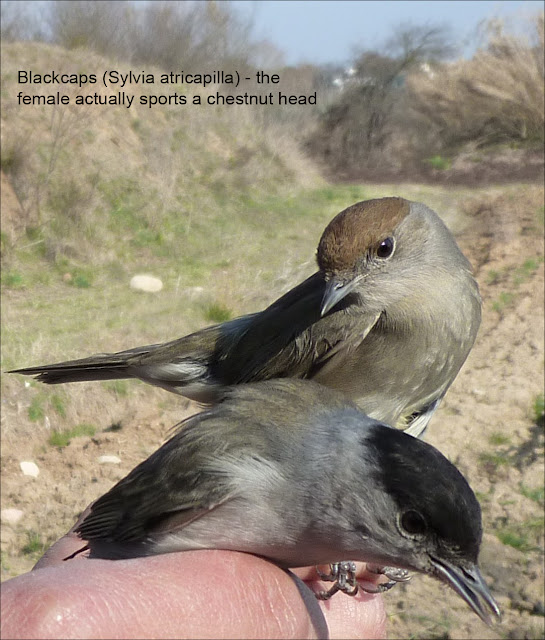Appeased somewhat after its violent attack on the fingers of Furquet, our catch glares at the camera - Picture: Abul Fazil
IT was
a serendipitous discovery, no less. We were on the lookout for Robins,
Tits, Blackcaps, Goldfinches and such like. The last thing we expected
to find was a Hawfinch (Coccothraustes coccothraustes) – and the mist nets of GOT’s Carles Furquet threw up two of them. The venue: Bassa de Pardaler (Sparrow Pond), a five-hectare expanse of farmland with a large grove of mainly poplars, Holm oak and walnut trees around a little lake, in the urbanised municipality of Lliça d’Amunt (pop. 13,500). The mist-net haul of the Hawfinches and seven other species kicked off a busy morning of bird-ringing, nestbox construction and their ceremonial hoisting high up strategically selected trees in the grove. About 40 parents and their children defied the freezing temperatures on Sunday (February 13) to participate in Project Nestbox, a study of avian activity carried out under GOT auspices by ornithologist and veteran ringer Furquet.
Few passerines could arouse as much excitement among birders as the enigmatic Hawfinch, at 17cm in length and 55g in weight one of the largest members of the finch family. With its bulky bull-head and a massive bill powerful enough to crush an olive seed in one go, it is awesome at close quarters. The head is a magnificent metallic brown with a black eye stripe and a bib. It is extremely difficult to spot, and its numbers appear to have declined over the years. Hawfinches perch high in trees, but also feed on the ground inconspicuously among the foliage. Neither of the two hawfinches caught in the net took too kindly to their entrapment, and both furiously tried to sink their beaks into Furquet’s fingers as he extricated them. The violent attacks left painful contusions on the fingers, but the ringer took it all in his stride as he carefully ringed and quickly released them. 

Harbinger of spring drops by
Also caught in the nets were a Cirl Bunting (Emberiza cirlus), Cetti's Warbler (Cettia cetti), Song Thrush (Turdus philomelos), Robin (Erithacus rubecula), a pair of Blackcaps (Sylvia atricapilla) and a Goldfinch (Carduelis carduelsi). The Song Thrush, a harbinger of spring, was another unexpected visitor -- the bird is generally associated with mature and well-wooded landscape and Sparrow Pond is not considered a mature habitat. Indeed, one reason why Project Nestbox was launched is to find out whether such environments could support a stable avian population.
The Cetti’s warbler (pronounced /ˈtʃɛti/ ) was also a rare sight. A rather nondescript, sulking bird, it is always heard but hardly ever seen as it hides out among reed beds – its favourite haunt. In Catalonia it is known as Rossinyol bord (Bastard Nightingale) because its song – which rings out in loud bursts – is frequently mistaken for that of a Rufous Nightingale (Luscinia megarhynchos).
After the ringing, the business of building nestboxes -- always a high point of GOT's Mornings with Nature -- began in earnest. This time, however, the boxes would end up on the trees around -- the first stage of Project Nestbox.
Left: Carles Furquet explains to Jan,6, why a bat nestbox looks so different. Right: Lluis leads the way to the nestbox sites.
Eight boxes were put up and over the next couple of months they are expected to be occupied by a variety of nesting birds. Furquet expects to see results as early as the middle of March. 


A birding session rounded up the morning, with Carles and bird-ringing assistant Ferran Pasqual identifying the sightings. Twelve species apart from those caught in the mist nets were seen, a modest but encouraging total for a highly urbanised zone.
The List, compiled by Ferran Pascual, includes the ringed species in red:
[English, Latin, Spanish, Catalan,German, french]
Blackcap, Sylvia atricapilla, Curruca Capirotada, Tallarol de casquet, Bergeronnette grise,Fauvette à tête noire
Cetti's Warbler, Cettia cetti, Ruiseñor Bastardo, Rossinyol bord, Seidensänger, Bouscarle de Cetti
Cirl Bunting, Emberiza cirlus, Escribano Soteño, Gratapalles, Zaunammer, Bruant zizi
Common Chaffinch, Fringilla coelebs, Pinzón Vulgar, Pinsà comú, Buchfink, Pinson des arbres
Common Starling, Sturnus vulgaris, Estornino Pinto, Estornell vulgar, Star, Étourneau sansonnet
Common Woodpigeon, Columba palumbus, Paloma Torcaz, Tudó, Ringeltaube, Pigeon ramier
Crested Lark, Galerida cristata, Cogujada Común, Cogullada vulgar, Haubenlerche, Cochevis huppé
Goldfinch, Carduelis carduelis, Jilguero, Cadernera, Stieglitz, Chardonneret élégant
Great Tit, Parus major, Carbonero Común, Mallerenga carbonera, Kohlmeise, Mésange charbonnière
Green Woodpecker, Picus viridis, Pito Real, Picot verd, Grünspecht, Pic verd
Greenfinch, Carduelis chloris, Verderón Común, Verdum, Grünling, verdier d'Europe
Grey Heron, Ardea cinerea, Garza Real, Bernat pescaire, Graureiher, Héron cendré
Hawfinch, Coccothraustes coccothraustes, Picogordo, Durbec, Kernbeisser, Gros-bec
Magpie, Pica pica, Urraca, Garsa, Blauelster, Pie bleue
Moorhen, Gallinula chloropus, Gallineta Común, Polla d'aigua, Teichrallen,Gallinule poule d'eau
Robin, Erithacus rubecula, Petirrojo Europeo, Pit-roig, Rotkehlchen, Rougegorge
Rock Dove, Columba livia, Paloma Bravía, Colom roquer, Felsentaube, Pigeon biset
Short-toed Eagle, Circaetus gallicu,s Culebrera Europea, Àguila marcenca, Schlangenadler, Circaète Jean-le-blanc
Siskin, Carduelis spinus, Lúgano, Lluer, Erlenzeisig, Tarin des aulnes
Song Thrush, Turdus philomelos, Zorzal Común, Tord comú, Singdrossel, Griv musicienne
What we didn't find was a single sparrow! Words & Pictures: Abul Fazil








Thanks for this wonderful chapter from Got'sInternational that takes us to the hunting down, catching and ringing and the making of nest boxes to keep a close watch,to understand and learn more of those most beautiful and quite rare birds in thoses places they were found.Well if sparrows are missing you can always see them here in the pacific everywhere!
ReplyDelete